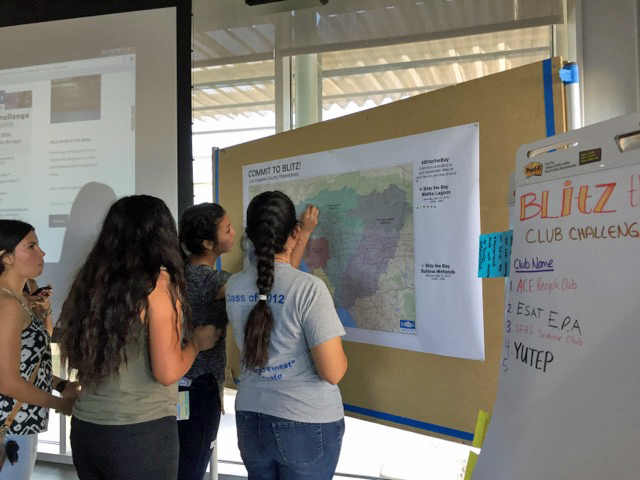Reaching New Heights at Our Youth Summits
Mar. 18, 2016 — Programs Associate Jenn Swart reports back on two Youth Summits she recently hosted for Club Heal the Bay members, as well as our upcoming BioBlitzes.
Los Angeles is facing some very real threats because of ongoing climate change, such as less reliable imported water supplies and significant sea-level rise. In response, Heal the Bay works to strengthen the natural landscapes that keep our urban environments resilient. Protecting our remaining lagoons and other wetlands is critical to this effort.
Our first line of defense is organizing two BioBlitzes – a concerted effort from scientists, teachers, students, families and all community members to catalogue as many species as possible in a given area over a short burst of time.
These blitzes, to be held April 30 and May 14 at Malibu Lagoon and the Ballona Wetlands, respectively, will take a real-time snapshot of the biodiversity in these threatened areas. All data are collected and managed by a free software application called iNaturalist.
It’s estimated that Los Angeles has already lost 95% of its coastal wetlands. And as efforts begin to restore areas like the Ballona Wetlands, it’s critical that the work is driven by sound science and accurate data. We are fortunate that a number of high school citizen scientists will help us map biodiversity.
Club Heal the Bay, our science and advocacy program for local middle and high school students, recently hosted two “Blitz the Bay” Youth Summits. We trained more than 50 teens on the ins and outs of the iNaturalist app while discussing the importance of biodiversity in our urban setting.
Katie Osaki, of Santa Monica High School’s Heal the Bay Club attended the Playa Vista summit with some of her club mates. Here she shares her experience:
Our club’s day began with cloudy skies and high hopes. Upon arrival we were greeted by two of the wonderful Heal the Bay programs associates and signed in — getting folders filled with information, recycled notebooks, and cute little magnifying glasses that we would use later in the day.
After, eating some of the delicious food from Vinny’s Pizza, we all went outside to participate in an ice breaker that taught us about the effects of pollution on species’ habitats and resources. Venturing back indoors, Lily (one of the Heal the Bay associates) introduced us to what a BioBlitz is and what its purpose is, which gave us a lot of great insight into the project and how we could contribute.
Shortly after, we all headed back outside into the sprinkling rain and got a tour of Ballona Discovery Park by Lisa Fimiani, a representative from Friends of Ballona Wetlands, who actually helped create this center for education and nature preservation. Along our tour, we got to hear the tragic story of Juana Maria and her 18 years of solitude on San Nicolas Island, which taught us how connected to nature the native Indians were and how disconnected the current occupants (us) are.
Through the different simulated habitats like the mountains, beach, and wetlands, we got to see many different species of plants and catalog them using iNaturalist, which is an “Instagram for naturalists.” As with Instagram, naturalists or citizen scientists can take pictures of different types of plants, animals, and insects (known or unknown), and post them on iNaturalist for other naturalists and citizen scientists to see and identify.
The Naturalist Explorers from the Mountain Recreation & Conservation Authority–a job training program for teens–helped all of us learn how to create an observation using the iNaturalist app on our phones. After twenty minutes of exploring and cataloging, we walked back to the Playa Vista Library and discussed what we had found interesting.
Then we got to teach the BioBlitz Dance, which our club had the honor of leading. With lots of giggles and embarrassing dance moves, we pulled it off and had a lot of fun.
When the day came to a close, it seemed like time had flown by. We all wanted to become more involved in the nature preserves in our areas. Unfortunately, we couldn’t go and tour the wetlands after the summit, but we have already started planning new creative events for our club that will help our members become just as interested in the environment as we are.
I think the most valuable thing we learned was that our species has worked very hard to make the lives of other species, such as the marine life along our coasts, very difficult. It’s unfortunate because the land we have settled and used is equally their land and we need to respect that more as technology advances and more toxic waste gets pumped into our air and open spaces.



If you are interested in joining our upcoming April 30 BioBlitz in Malibu Lagoon, click here. If you are interested in helping us at our Ballona Wetlands event on May 14, click here.


